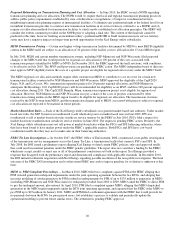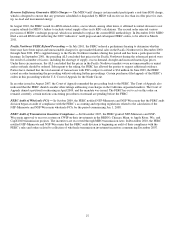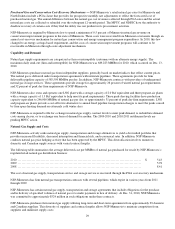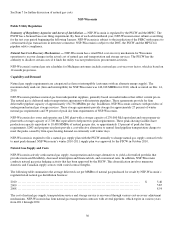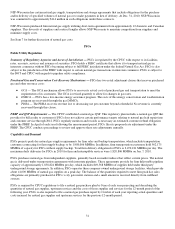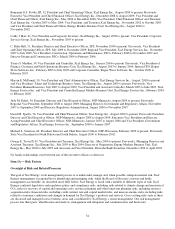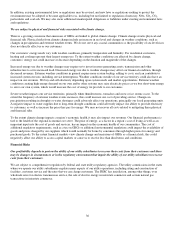Xcel Energy 2010 Annual Report Download - page 39
Download and view the complete annual report
Please find page 39 of the 2010 Xcel Energy annual report below. You can navigate through the pages in the report by either clicking on the pages listed below, or by using the keyword search tool below to find specific information within the annual report.29
Purchased Gas and Conservation Cost-Recovery Mechanisms — NSP-Minnesota’s retail natural gas rates for Minnesota and
North Dakota include a PGA clause that provides for prospective monthly rate adjustments to reflect the forecasted cost of
purchased natural gas. The annual difference between the natural gas cost revenues collected through PGA rates and the actual
natural gas costs are collected or refunded over the subsequent 12-month period. The MPUC and NDPSC have the authority to
disallow recovery of certain costs if they find the utility was not prudent in its procurement activities.
NSP-Minnesota is required by Minnesota law to spend a minimum of 0.5 percent of Minnesota natural gas revenue on
conservation improvement programs in the state of Minnesota. These costs were recovered from Minnesota customers through an
annual cost-recovery mechanism for natural gas conservation and energy management program expenditures. In 2010, this law
changed to an energy savings-based requirement, and the costs of conservation improvement programs will continue to be
recoverable in Minnesota through a rate adjustment mechanism.
Capability and Demand
Natural gas supply requirements are categorized as firm or interruptible (customers with an alternate energy supply). The
maximum daily send-out (firm and interruptible) for NSP-Minnesota was 689,223 MMBtu for 2010, which occurred on Dec. 13,
2010.
NSP-Minnesota purchases natural gas from independent suppliers, generally based on market indices that reflect current prices.
The natural gas is delivered under transportation agreements with interstate pipelines. These agreements provide for firm
deliverable pipeline capacity of 585,598 MMBtu per day. In addition, NSP-Minnesota contracts with providers of underground
natural gas storage services. These agreements provide storage for approximately 26 percent of winter natural gas requirements
and 32 percent of peak day firm requirements of NSP-Minnesota.
NSP-Minnesota also owns and operates one LNG plant with a storage capacity of 2.0 Bcf equivalent and three propane-air plants
with a storage capacity of 1.3 Bcf equivalent to help meet its peak requirements. These peak-shaving facilities have production
capacity equivalent to 246,000 MMBtu of natural gas per day, or approximately 31 percent of peak day firm requirements. LNG
and propane-air plants provide a cost-effective alternative to annual fixed pipeline transportation charges to meet the peaks caused
by firm space heating demand on extremely cold winter days.
NSP-Minnesota is required to file for a change in natural gas supply contract levels to meet peak demand, to redistribute demand
costs among classes, or to exchange one form of demand for another. The 2009-2010 and 2010-2011 entitlement levels are
pending MPUC action.
Natural Gas Supply and Costs
NSP-Minnesota actively seeks natural gas supply, transportation and storage alternatives to yield a diversified portfolio that
provides increased flexibility, decreased interruption and financial risk, and economical rates. In addition, NSP-Minnesota
conducts natural gas price hedging activity that has been approved by the MPUC. This diversification involves numerous
domestic and Canadian supply sources with varied contract lengths.
The following table summarizes the average delivered cost per MMBtu of natural gas purchased for resale by NSP-Minnesota’s
regulated retail natural gas distribution business:
2010 ................................................................................................
.
$5.43
2009 ................................................................................................
.
5.78
2008 ................................................................................................
.
8.41
The cost of natural gas supply, transportation service and storage service is recovered through the PGA cost-recovery mechanism.
NSP-Minnesota has firm natural gas transportation contracts with several pipelines, which expire in various years from 2011
through 2029.
NSP-Minnesota has certain natural gas supply, transportation and storage agreements that include obligations for the purchase
and/or delivery of specified volumes of natural gas or to make payments in lieu of delivery. At Dec. 31, 2010, NSP-Minnesota
was committed to approximately $524 million in such obligations under these contracts.
NSP-Minnesota purchases firm natural gas supply utilizing long-term and short-term agreements from approximately 29 domestic
and Canadian suppliers. This diversity of suppliers and contract lengths allows NSP-Minnesota to maintain competition from
suppliers and minimize supply costs.









